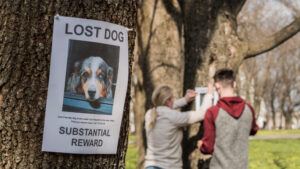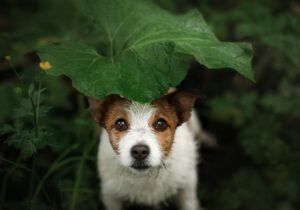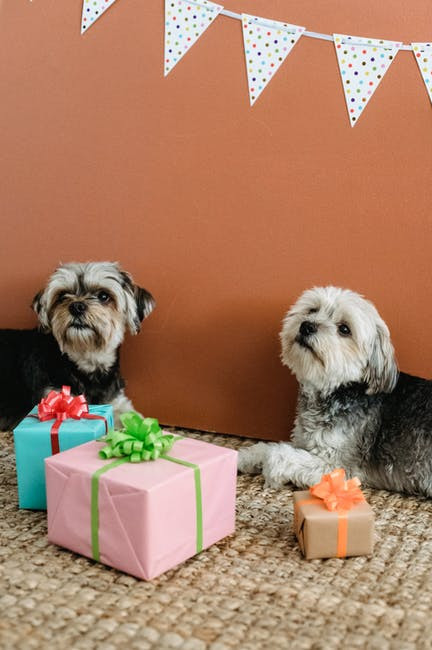How to Hunt for Your Lost Dog: Top Tips
LifeWithMyDogs is supported by our audience. When you purchase through one of our links, we may earn a small affiliate commission. As an Amazon Associate I earn from qualifying purchases. Your cost is not affected.
**********
How to Hunt for Your Lost Dog
 Dogs are lovely to have as pets. They love to play games. If you meet someone with a dog, it is natural for you to want one too. However, dogs are not the easiest pets to take care of.
Dogs are lovely to have as pets. They love to play games. If you meet someone with a dog, it is natural for you to want one too. However, dogs are not the easiest pets to take care of.
To help us better understand how big of an issue pets running away can be, The American Humane Association reports that about 10 million dogs and cats run away every year in the United States alone.
But what should we do if our dog runs away? How does one go on a wild goose chase looking for their beloved pet? It’s time to learn how to hunt for your lost dog!
Ways on How to Hunt for Your Lost Dog
1) Call Animal Control.
The first thing you need to do is contact animal control within your state or town. The police will help try and locate your pup by setting up ‘lost’ flyers and putting out an APB (all points bulletin).
2) Find a Dog Walker.
If you’re desperate and need to find your dog fast, try finding someone who can walk dogs in your area. You can go door-to-door or post flyers asking for help. Letting the public know that you will pay people who get leads on your lost dog could mean getting lucky and finding your pet much faster than anticipated! Advertise this reward fund with flyers, posters, social media, and other means if possible.
3) Use Social Media.
Post on all of your social media accounts such as Facebook and Instagram about how your dog is lost along with a photo of him/her and any contact information you may have for yourself. This helps spread the news and it is possible that someone may spot your pup and contact you with a lead!
4) Spread the Word Locally.
Go around to as many places as you can, such as schools, veterinary clinics, pet supply stores, groomers, dog parks, or anywhere else there may be a large number of people who walk their dogs. Let them know that you have lost your dog and what he/she looks like. If they happen to see your pup they will know to call you immediately!
5) Walk Around Your Neighborhood at Night with a Flashlight and Dog Treats.
Take a flashlight on one of your walks around town at night so that if your dog does turn up missing again then you can spot the little rascal! Also, take some dog treats in your pocket to lure your pup back home. Make sure you are wearing bright clothing when walking around at night so that people can see you and call out to you if they do happen to see your lost dog.
6) Search all Likely Places Twice Daily.
Make a list of all of the places where you think your pup may be hiding or laying low for a while because he/she is stressed after running away. Then search each one between once and twice daily until your dog is found. Look under houses, in garages, in sheds, inside closets, etc. Some dogs will even jump into a car’s engine if it’s left open long enough without someone in it, so make sure to search in and around the car too!
7) Have Flyers Ready.
Print out multiple copies of your lost dog’s picture/description for you to give to anyone who may see your pup. Make flyers with simple text that says something like ‘Reward if Found’ or ‘Missing Dog’. Include your phone number on the flyer which you can fold up along with a photo or description of your lost dog (include age, breed, size, distinguishing features i.e. long hair / short hair; spots; etc.). Also, include where he/she was last seen and when they were missing because this gives people an idea of how long they’ve been gone which helps track time which could lead to finding them sooner.
8) Don’t Give Up!
Keep on searching for your pup, even if the first few weeks pass by with no sign of him/her. Missing dogs can sometimes take months before they are found so you need to be patient and determined in order to find them. One website says that almost one-third of dogs who run away end up making it back home within three days but others are not as lucky. Some examples include a Beagle who was lost for six years only to return home last week or an Akita who went missing five years ago this April and still has not been found.
These examples show how dedicated owners will do anything they can to find their pets which is why they should be incredibly thankful that there are people out there willing to help them get their beloved pets back where they belong! If you have lost your dog then don’t hesitate to ask for help by calling the Animal Control Center, neighboring cities, or just anyone who may be able to give some leads.
What To Do If My Is Still Missing 24 Hours After
 If your dog is still missing after a full day has passed, call the Animal Control Center to report it. In some cities, they will decide whether or not to keep looking for your dog based on how long he’s been gone. If the AC is going to continue searching for him/her, they’ll check in with you daily and you should look for them at all of the places that your lost dog typically goes (i.e., favorite hiding spots).
If your dog is still missing after a full day has passed, call the Animal Control Center to report it. In some cities, they will decide whether or not to keep looking for your dog based on how long he’s been gone. If the AC is going to continue searching for him/her, they’ll check in with you daily and you should look for them at all of the places that your lost dog typically goes (i.e., favorite hiding spots).
If your pup is wearing any identification tags or microchips then make sure that you listed the emergency contact number. Since this way, if someone finds him/her then they can get in touch with you without delay! Consider hiring professional pet detective specializing in finding lost pets because they may be able to find your dog faster. If you’re not sure how much it costs to hire one, look for advertisements in the newspaper or search online because there are plenty of them out there.
Conclusion
If you experienced your dog going missing, it is natural to be worried, sad, and desperate. You may not know where he/she went or who has them. You may find yourself chasing after shadows everywhere or the lost dog signs posted in every neighborhood you pass by. Don’t give up hope! Your pet is out there somewhere waiting for you too! And I hope this “How to Hunt for Your Lost Dog” article helps you a lot.
Read More:
http://www.vetstreet.com/care/puppy-basics-101-how-to-care-for-your-new-dog







